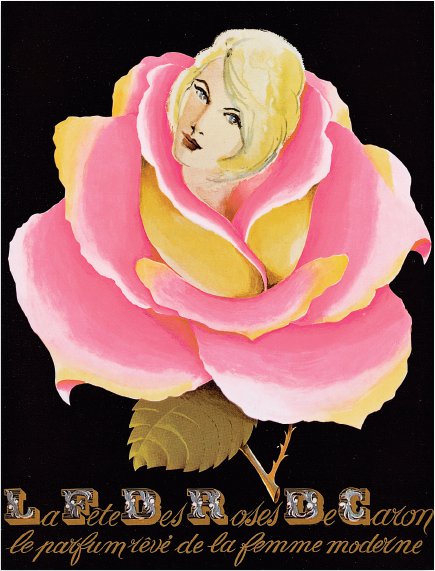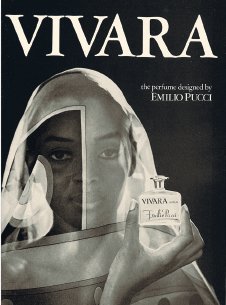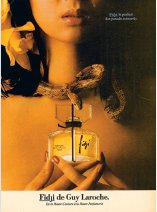Scent and Subversion (17 page)
Read Scent and Subversion Online
Authors: Barbara Herman


A 1960s ad for Caron’s 1936 perfume
by Yves Saint Laurent (1964)
Perfumer:
Jean Amic
Like summer in a bottle, Yves Saint Laurent’s first fragrance, Y, is a lighthearted chypre. Its sunny disposition goes along with the traditional intelligence, good taste, and gravitas most chypres convey.
It opens with galbanum and honeysuckle singing the highest notes, as peach and honey smooth their edges with warm sweetness. The honey is particularly intense and signals the unexpected animalic nature of Y, providing volume and depth to the flowers and fruit.
By the time you arrive at the heart notes, the fragrance is already winding down into mossy creaminess. Y’s visual equivalent would be those sunburst reflections you see in ’70s movies. There’s always a kind of melancholy quality to those sun rays, which are visual metaphors for being aware of a happy moment, and as a result, no longer inhabiting it fully. Civet functions here in the perfume’s unconscious like a microexpression of disquiet or melancholy, barely detectable.
Top notes:
Galbanum, peach, honey, honeysuckle
Heart notes:
Rose, jasmine, orris, hyacinth, ylang-yalng
Base notes:
Oakmoss, amber, patchouli, civet, vetiver, benzoin
by Shiseido (1964)
Perfumer:
Josephine Catapano
A fruit and floral chypre, Zen manages to be both perfectly composed and yet strangely wild and free, like a haphazard flower arrangement following the Japanese aesthetic of
wabi-sabi,
which values the paradoxical qualities of imperfection, impermanence, and incompletion.
Its initial sparkling fruit and flower notes slide into the rich, plummy plushness of soft woods and warmth. I can’t tell you what I like more—Zen as it’s coming my way, in my first flush of falling in love with its sharp flowery/fruity sparkle, or as it nuzzles up close to me, after I understand it and we spend some time together in its woodsy, ambery state.
Bright, fruity, floral, spicy, warm, ambery—I am dazzled by how much this perfume says in a whisper. Its drydown does not ignore what came before it, but marvelously carries the colors of those notes until they all resolve into a soft reverie—like a camera’s soft-focus image of a garden.
Top notes:
Bergamot, galbanum, orange blossom
Heart notes:
Jasmine, rose, narcissus, violet, orris, mimosa, hyacinth, carnation
Base notes:
Sandalwood, cedar, oakmoss, amber, musk
by Estée Lauder (1965)
Perfumer:
Bernard Chant
The short review: Mint, herbs, BO, Naugahyde, and the smell of Burt Reynolds’s chest hair in the 1970s. But seriously …
This glorious leather chypre starts off with a wonderful fresh/bitter herbaceousness combined with a very prominent body-odor note from cumin. Please note: The cumin here doesn’t just suggest your run-of-the-mill perspiration; the body odor note in Aramis is the smell of the armpits of a man who’s been exercising for a while and possibly hasn’t bathed in a couple days. It has that almost-metallic sharpness that accompanies the aroma of an especially ripe pair of pits. Jarring—but sexy, in the way that smelling the body odor of someone you’re attracted to can be both repellent and erotic.
Beautifully blended gardenia, jasmine, amber, and sandalwood sweeten and warm the scent almost immediately, giving Aramis a comforting softness that invites you to snuggle with it on its Naugahyde couch. (Just snuggling, it promises!)
But don’t believe Aramis’s innocent act; this cologne has carnal intent. As it starts to dry down, the well-worn suede portion of the scent comes forth, primarily through the amazingly creamy and smoky castoreum and leather accord.
Although this is a masculine scent, I’m going to wear it myself. It’s reminiscent, in fact, of many 1960s animalic chypres for women, like Fête de Molyneux (1962) and Miss Balmain (1967). Although less animalic, the reformulation is quite nice.
Top notes:
Artemisia, aldehydes, bergamot, gardenia, green note, cumin
Heart notes:
Jasmine, patchouli, orris, vetiver, sandalwood
Base notes:
Leather, oakmoss, castoreum, amber, musk
by Lanvin (1965)
Crescendo
is a musical term describing a composition’s increasing volume. Crescendo, the perfume, expresses this musical metaphor by amping its notes from feminine to masculine. Soon after I popped open the tiny bottle, Crescendo’s bracing floral to spicy scent went from zero to sixty in record speed. Its light floral heart is surrounded by spice and intrigue, and the crescendo of intensity ends in soft, rich incense. At it lingers on my skin, this floral scent tinged with tobacco and leather seems to get spicier.
Notes:
Iris, carnation, hyacinth, amber, incense, spices
(Notes from Fragrantica.com.)
by Coty (1965)
Rosy, green, and lemony-geranium notes, lifted by aldehydes, radiate from the core of this ladylike fragrance, as put together as a 1960s suit with matching shoes and pocketbook. As Imprévu (“Unexpected”) dries down, orris and sandalwood, with a touch of animalic honey, create a woody-powdery base that will smell like an “old lady” to the uninitiated, and sensual and dreamy to those of us who are used to it.
Top notes:
Aldehydes, leafy green, bergamot, coriander
Heart notes:
Rose, geranium, lily of the valley, orris, honey
Base notes:
Sandalwood, tonka, cedarwood, oakmoss, musk, vetiver
by Emilio Pucci (1965)

In this 1970s ad for Vivara, a woman is veiled with a Pucci-printed scarf.
Vivara is an herby green chypre with a subtle rose heart, bitter shots of galbanum and lemon, and a mossy, animalic base reminiscent of Bandit’s. It progresses from a sunny, bright scent to a sensual, galbanumtinged-plus-costus skin accord. Perfume gods, please bring back green-leather chypres! Or at least let me hoard a lifetime supply. Perfumer Yann Vasnier’s assessment: “It’s a green chypre à la Cabochard but spicier, maybe with galbanum, clove, and a really fatty costus.”
Top notes:
Galbanum, lemon, bergamot
Heart notes:
Cypress, May rose, Bulgarian rose
Base notes:
Mysore sandalwood, labdanum
by Christian Dior (1966)
Perfumer:
Edmond Roudnitska
A classic unisex fragrance that surely influenced the clean scents of the 1990s, Eau Sauvage has been described as Roudnitska’s 1972 Diorella without its peach note. It starts off with wonderfully crisp lemon and basil top notes, enhanced by bergamot and a fruity—maybe melon?—note. Subtle spice and woods add dimension to the radiant citrus notes, and coriander and cumin contribute subtle, disquieting funkiness. Eau Sauvage is a landmark perfume because of Roudnitska’s 2 percent dosage of Hedione, a chemical discovered by Firmenich in 1959 that brings a veil of transparent jasmine to this masculine fragrance. According to perfumer Pierre Bourdon, “[Eau Sauvage] used to be very green and fresh. Today, it has been replaced by something softer and duller.” He attributes this to the removal of furocoumarins, a class of organic chemical compounds found in ingredients like bergamot that have been known to create dark spots on the skin when exposed to the sun.
As clean as Eau Sauvage is, its subliminal civet note evokes the olfactory impression of a freshly showered man who nevertheless retains a whiff of body odor he can’t wash off completely. Clean mixed in with a stubborn, human scent. It’s a sexy combination, particularly striking in a scent so clean and fresh.
Top notes:
Bergamot, lemon, basil, cumin, fruit note
Heart notes:
Jasmine, patchouli, carnation, coriander, orris, sandalwood
Base notes:
Oakmoss, amber, musk
by Guy Laroche (1966)

In this 1982 ad, we’re given a Gauguinesque fantasy for “Fidji: the perfume of paradise found.”
Perfumer:
Josephine Catapano
Fidji starts off green-fresh in its top notes, moves into a radiant jasmine/rose, and, softened by buttery orris, it dries down to a woody and spicy warmth.
By the time Fidji dries down, I smell a golden rose, kept fresh by galbanum and citrus notes, fattened by orris, with the slightest woody spice of sandalwood and oakmoss. The volume of its initial, intense rush of greens and florals is turned down, but Fidji’s quiet, gorgeous presence lingers for hours.
The light-colored reformulation of Fidji isn’t as rich as the vintage; it smells watery and transparent. The florals also aren’t followed up by the warming base notes found in the original formula, making the reformulated Fidji seem one-dimensional and lacking the dreamy mood the multifaceted original creates. The reformulation also just smells cheaper than the original. This lack of evolution from green to floral to spicy/woody/warm in the reformulation is like a day on the beach without a sunset—namely, not good.
Top notes:
Galbanum, hyacinth, bergamot, lemon
Heart notes:
Carnation, orris, jasmine, rose, ylang-ylang
Base notes:
Vetiver, musk, sandalwood, oakmoss
by Judith Muller (1967)
Perfumer:
Sophia Grojsman
Imagine if a pungent rose petal had been dipped into a pot of honey, sandalwood, and amber, and you get a sense of the narcotic allure of Sophia Grojsman’s first composition, Bat-Sheba. It has the elegance and structure of a chypre, the heady sweetness of a floral, and the sexy spice of an Oriental.
Bat-Sheba’s contrasting intensities of floral, fruit, and green notes heighten the dark and sultry base, and already in Grojsman’s first composition is her signature lush complexity. In the not-so-savory biblical backstory, King David spied Bathsheba bathing and was so taken with her that he lost his senses, committing adultery and who knows what else. Perfumer Yann Vasnier has described Bat-Sheba as reminiscent of Miss Dior.
Notes from
Octavian Coifan:
Cactus, rosewood, vanilla/cocoa balsamic and chypre-woody base, powders, and isobutyl quinoline woody note
Notes from
Yann Vasnier:
Aldehydes, citrus, green notes, rose, chypre, patchouli
by Robert Piguet (1967)
Released under Robert Piguet’s name fourteen years after the couturier’s death, Futur had a brief life span, discontinued just seven years later, in 1974. The scent’s longevity, like the perfume’s brief life, has a shooting star (or racing rocket?) quality. As I put it on my skin, its piquant, joyous burst of citrus and flowers turns into something lush and animalic. It is a strangely patched-together perfume, in terms of mood and temperament, with the liftoff of bitter green and florals descending back to earth (and back in time, to the ’50s!) with a lushness reminiscent of Baghari.
Bitter, fresh, floral, smoky, incensey, and then buttery animalic—the new Futur has a lot to live up to. This gorgeous thing reminds me of Piguet’s Baghari, and the near-ripe
fruit plus incense I smell reminds me of Jean-Claude Ellena’s green-mango inspired Un Jardin sur le Nil.
Notes from
Octavian Coifan:
Bitter thyme- and basil-like notes, vetiver, isobutyl quinoline, galbanum, Tamarix
Notes from
The Scented Salamander’s Chantal-Hélène Wagner:
Galbanum, hyacinth, narcissus, daffodil, leather
